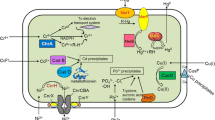Abstract
Ion exchange or biosorptive processes for metalremoval generally lack specificity in metal bindingand are sensitive to ambient conditions, e.g. pH,ionic strength and the presence of metal chelators. Inthis study, cells of a genetically engineered Escherichia coli strain, JM109, which expressesmetallothionein and a Hg2+ transport system afterinduction were evaluated for their selectivity forHg2+ accumulation in the presence of sodium,magnesium, or cadmium ions and their sensitivity to pHor the presence of metal chelators during Hg2+bioaccumulation. The genetically engineered E.coli cells in suspension accumulated Hg2+effectively at low concentrations (0-20 µM) overa broad range of pH (3 to 11). The presence of 400 mMsodium chloride, 200 mM magnesium chloride, or100 µM cadmium ions did not have a significanteffect on the bioaccumulation of 5 µm Hg2+,indicating that this process is not sensitive to highionic strength and is highly selective against sodium,magnesium, or cadmium ions. Metal chelators usuallyinterfere with ion exchange or biosorptive processes.However, two common metal chelators, EDTA and citrate,had no significant effect on Hg2+ bioaccumulationby the genetically engineered strain. These resultssuggest that this E. coli strain could be usedfor selective removal of Hg2+ from waste water orfrom contaminated solutions which are resistant tocommon treatments. A second potential applicationwould be to remove Hg2+ from Hg2+-contaminated soil, sediment, or particulates bywashing them with a Hg2+ chelator andregenerating the chelator by passing the solutionthrough a reactor containing the strain.
Similar content being viewed by others
References
Archibald F & Duong MN (1984) Manganese acquisition by Lactobacillus plantarum. J. Bacteriol. 158: 1–8
Barkay T, Turner R, Saouter E & Horn J (1992) Mercury biotransformations and their potential for remediation of mercury contamination. Biodegradation 3: 147–159
Bartolome B, Jubete Y, Martinez E & Cruz F (1991) Construction and properties of a family of pACYC184-derived cloning vectors compatible with pBR322 and its derivatives. Gene 102: 75–78
Bedell GW & Darnall DW (1990) Immobilization of nonviable biosorbent, algal biomass for the recovery of metal ions. In: Volesky B (Ed) Biosorption of Heavy Metals, (pp 313–326). CRC press, Boca Raton, FL, USA
Chang JS & Hong J (1994) Biosorption of mercury by the inactivated cells of pseudomonas aeuginosaPU21 (Rip64). Biotechnol. Bioeng. 44: 999–1006
Chen S-L & Wilson DB. Appl. Environ. Microbiol. (in press) Crosa JH (1989) Genetics and molecular biology of siderophore-mediated iron transport in bacteria. Microbiol. Rev. 53: 517–530
Darimont A & Frenay J (1990) Metals in aqueous solutions. In: Volesky B (Ed) Biosorption of Heavy Metals (pp 65–80). CRC press, Boca Raton, FL., USA
Darnall DW, Greene B, Hosea M, McPherson RA, Henzl M & Alexander MD (1986) Recovery of heavy metals by immobilized algae. In: Thompson R (Ed) Trace Metal Removal from Aqueous Solution. The Royal Society of Chemistry, London, UK
Diels L, Dong Q, Van der Lelie D, Baeyens W & Mergeay A (1995) The czc operon of Alcaligenes eutrophusCH34: from resistance mechanism to the removal of heavy metals. J. Ind. Microbiol. 14(2): 142–153
Drapeau AJ, Laurence RA, Saint-Germain G, Harbec PS & Lambert NG (1983) Bioaccumulation of heavy metals bymicroorganisms. Sci. Tech. Eau 16: 359–363
Gadd GM (1988) Accumulation of metals by microorganisms and algae. In: Rehm HJ & Reed G (Eds) Biotechnology, Vol 6b (pp 401–430). VCH, Weinheim, Germany
Gounot A-M (1994) Microbial oxidation and reduction of manganese: consequences in groundwater and application. FEMS Microbiol. Rev. 14: 339–350
Hatch WR & Ott WL (1968) Determination of sub-microgram quantities of mercury by atomic spectrophotometry. Anal. Chem. 40: 2085–2087
Kurland LT, Faro SN & Sieldler H (1960) Minamata disease: the outbreak of a neurological disorder in Minamata, Japan, and its relationship to the ingestion of seafood contaminated bymercuric compounds. World Neurol. 1: 370–395
Kusano T, Ji GY, Inoue C & Silver S (1990) Constitutive synthesis of a transport function encoded by the Thiobacillus ferrooxidans merCgene cloned in Escherichia coli.J. Bacteriol. 172: 2688–2692
Macaskie LE, Jeong BC & Tolley MR (1994) Enzymatically accelerated biomineralization of heavymetals: application to the removal of americium and plutonium from aqueous flows. FEMS Microbiol. Rev. 14: 351–368
Morby AP, Hobman JL & Brown NL (1995) The role of cysteine residues in the transport of mercuric ions by the Tn501 MerT and MerP mercury-resistance proteins. Mol. Microbiol. 17: 25–35 Mukhopadhyary D, Yu H, Nucifora G & Misra T (1991) Purification and functional characterization of MerD. J. Biol. Chem. 266: 18538-18542
Osteen AB & Bibler JP (1991) Treatment of radioactive laboratory waste for mercury removal. Water Air Soil Pollut. 56: 63–74 Pazirandeh M, Chrisey LA, Mauro JM, Campbell JR & Gaber BP (1995)Expression of the Neurospora crassametallothionein gene in Escherichia coliand its effect on heavy-metal uptake. Appl. Microbiol. Biotechnol. 43: 1112-1117
Ritter JA & Bibler JP (1992) Removal of mercury from waste water: large scale performance of an ion exchange process. Water Sci. Technol. 25(3): 165–172
Sahlman L & Granstroem Skaerfstad E (1993) Mercuric ion binding abilities of MerP variants containing only one cysteine. Biochem. Biophys. Res. Commun 196: 583–588
Sandstede G, Koehling A & Schoenbucher A (1993) Removal of mercury and other heavy metals from soils and sludges. Ger Offen DE 4, 212, 322 October
Spry DJ & Wiener JG (1991) Metal bioavailability and toxicity to fish in low-alkalinity lakes: a critical review. Environ. Pollut. 71: 243–304
Tommey AM, Shi J, Lindsay WP, Urwin PE & Robinson NJ. (1991) Expression of the pea gene PsMTA in E. colimetal-binding properties of the expressed protein. FEBS 292: 48–52
Volesky B & Holan ZR (1995) Biosorption of heavymetals. Biotechnol. Prog. 11: 235–250
Wasay SA, Arnfalk P & Tokunaga S (1995) Remediation of a soil polluted bymercury with acidic potassium iodide. J. HazardMatter 44: 93–102
Yanisch-Perron C, Vieira J & Messing J (1985) ImprovedM13 phage cloning vectors and host strains: nucleotide sequences of the M13mp18 and pUC19 vectors and new Escherichia colihost strain construction. Gene 33: 103–119
Author information
Authors and Affiliations
Rights and permissions
About this article
Cite this article
Chen, S., Wilson, D.B. Genetic engineering of bacteria and their potential for Hg2+ bioremediation. Biodegradation 8, 97–103 (1997). https://doi.org/10.1023/A:1008233704719
Issue Date:
DOI: https://doi.org/10.1023/A:1008233704719




